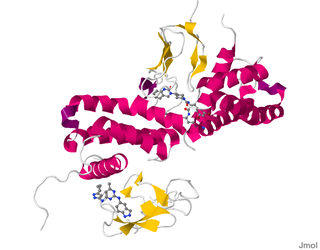Related Research Articles

Calcitonin is a 32 amino acid peptide hormone secreted by parafollicular cells (also known as C cells) of the thyroid (or endostyle) in humans and other chordates in the ultimopharyngeal body. It acts to reduce blood calcium (Ca2+), opposing the effects of parathyroid hormone (PTH).

Vasodilation, also known as vasorelaxation, is the widening of blood vessels. It results from relaxation of smooth muscle cells within the vessel walls, in particular in the large veins, large arteries, and smaller arterioles. The process is the opposite of vasoconstriction, which is the narrowing of blood vessels.

Bradykinin (BK) (Greek brady-, slow; -kinin, kīn(eîn) to move) is a peptide that promotes inflammation. It causes arterioles to dilate (enlarge) via the release of prostacyclin, nitric oxide, and endothelium-derived hyperpolarizing factor and makes veins constrict, via prostaglandin F2, thereby leading to leakage into capillary beds, due to the increased pressure in the capillaries. Bradykinin is a physiologically and pharmacologically active peptide of the kinin group of proteins, consisting of nine amino acids.
Transient receptor potential channels are a group of ion channels located mostly on the plasma membrane of numerous animal cell types. Most of these are grouped into two broad groups: Group 1 includes TRPC, TRPV, TRPVL, TRPM, TRPS, TRPN, and TRPA. Group 2 consists of TRPP and TRPML. Other less-well categorized TRP channels exist, including yeast channels and a number of Group 1 and Group 2 channels present in non-animals. Many of these channels mediate a variety of sensations such as pain, temperature, different kinds of tastes, pressure, and vision. In the body, some TRP channels are thought to behave like microscopic thermometers and used in animals to sense hot or cold. Some TRP channels are activated by molecules found in spices like garlic (allicin), chili pepper (capsaicin), wasabi ; others are activated by menthol, camphor, peppermint, and cooling agents; yet others are activated by molecules found in cannabis or stevia. Some act as sensors of osmotic pressure, volume, stretch, and vibration. Most of the channels are activated or inhibited by signaling lipids and contribute to a family of lipid-gated ion channels.
Neurogenic inflammation is inflammation arising from the local release by afferent neurons of inflammatory mediators such as Substance P, Calcitonin Gene-Related Peptide (CGRP), neurokinin A (NKA), and endothelin-3 (ET-3). In such neurons, release of these pro-inflammatory mediators is thought to be triggered by the activation of ion channels that are the principal detectors of noxious environmental stimuli. In particular, the heat/capsaicin receptor TRPV1 and the irritant/wasabi receptor TRPA1. TRPA1 channels stimulated by lipopolysaccharide (LPS) may also cause acute neurogenic inflammation. Once released, these neuropeptides induce the release of histamine from adjacent mast cells. In turn, histamine evokes the release of substance P and calcitonin gene-related peptide; thus, a bidirectional link between histamine and neuropeptides in neurogenic inflammation is established.

The neuroimmune system is a system of structures and processes involving the biochemical and electrophysiological interactions between the nervous system and immune system which protect neurons from pathogens. It serves to protect neurons against disease by maintaining selectively permeable barriers, mediating neuroinflammation and wound healing in damaged neurons, and mobilizing host defenses against pathogens.
Calcitonin gene-related peptide (CGRP) is a member of the calcitonin family of peptides consisting of calcitonin, amylin, adrenomedullin, adrenomedullin 2 (intermedin) and calcitonin‑receptor‑stimulating peptide. Calcitonin is mainly produced by thyroid C cells whilst CGRP is secreted and stored in the nervous system. This peptide, in humans, exists in two forms: CGRP alpha, and CGRP beta. α-CGRP is a 37-amino acid neuropeptide and is formed by alternative splicing of the calcitonin/CGRP gene located on chromosome 11. β-CGRP is less studied. In humans, β-CGRP differs from α-CGRP by three amino acids and is encoded in a separate, nearby gene. The CGRP family includes calcitonin (CT), adrenomedullin (AM), and amylin (AMY).

Adrenomedullin is a vasodilator peptide hormone of uncertain significance in human health and disease. It was initially isolated in 1993 from a pheochromocytoma, a tumor of the adrenal medulla: hence the name.
TRPC is a family of transient receptor potential cation channels in animals.

Receptor activity modifying protein 2, also known as RAMP2, is a protein which in humans is encoded by the RAMP2 gene.

Antimigraine drugs are medications intended to reduce the effects or intensity of migraine headache. They include drugs for the treatment of acute migraine symptoms as well as drugs for the prevention of migraine attacks.

Short transient receptor potential channel 5 (TrpC5) also known as transient receptor protein 5 (TRP-5) is a protein that in humans is encoded by the TRPC5 gene. TrpC5 is subtype of the TRPC family of mammalian transient receptor potential ion channels.

Calcitonin receptor-like (CALCRL), also known as the calcitonin receptor-like receptor (CRLR), is a human protein; it is a receptor for calcitonin gene-related peptide.

N-Arachidonoyl dopamine (NADA) is an endocannabinoid that acts as an agonist of the CB1 receptor and the transient receptor potential V1 (TRPV1) ion channel. NADA was first described as a putative endocannabinoid (agonist for the CB1 receptor) in 2000 and was subsequently identified as an endovanilloid (agonist for TRPV1) in 2002. NADA is an endogenous arachidonic acid based lipid found in the brain of rats, with especially high concentrations in the hippocampus, cerebellum, and striatum. It activates the TRPV1 channel with an EC50 of approximately of 50 nM which makes it the putative endogenous TRPV1 agonist.

DNA-directed RNA polymerase III subunit RPC9 is an enzyme that in humans is encoded by the CRCP gene.
Zucapsaicin (Civanex) is a medication used to treat osteoarthritis of the knee and other neuropathic pain. It is applied three times daily for a maximum of three months. Zucapsaicin is a member of phenols and a member of methoxybenzenes It is a modulator of transient receptor potential cation channel subfamily V member 1 (TRPV-1), also known as the vanilloid or capsaicin receptor 1 that reduces pain, and improves articular functions. It is the cis-isomer of capsaicin. Civamide, manufactured by Winston Pharmaceuticals, is produced in formulations for oral, nasal, and topical use.

Umbellulone is a headache-inducing monoterpene ketone found in the leaves of the tree Umbellularia californica, sometimes known as the "headache tree".
Calcitonin gene-related peptide (CGRP) receptor antagonists are a class of drugs that act as antagonists of the calcitonin gene-related peptide receptor (CGRPR).

Wasabi receptor toxin (WaTx) is the active component of the venom of the Australian black rock scorpion Urodacus manicatus. WaTx targets TRPA1, also known as the wasabi receptor or irritant receptor. WaTx is a cell-penetrating toxin that stabilizes the TRPA1 channel open state while reducing its Ca2+-permeability, thereby eliciting pain and pain hypersensitivity without the neurogenic inflammation that typically occurs in other animal toxins.

Iain Macintyre FRS was a British endocrinologist who made important contributions to the understanding of calcium regulation and bone metabolism. Shortly after the hormone calcitonin had been described by Harold Copp, Macintyre's team was the first to isolate and sequence the hormone and to demonstrate its origin in the parafollicular cells of the thyroid gland. He subsequently analysed its physiological actions. Along with H. R. Morris he isolated and sequenced calcitonin gene-related peptide. Later research centred on the role played by nitric oxide on bone metabolism.
References
- ↑ Susan Brain's ORCID 0000-0002-9684-8342
- ↑ "Susan Brain – CGRP Education & Research Forum". 20 March 2017. Retrieved 17 October 2019.
- ↑ "Professor Susan Brain". www.kcl.ac.uk. Archived from the original on 17 October 2019. Retrieved 17 October 2019.
- ↑ Sousa-Valente, João; Brain, Susan D. (2018). "A historical perspective on the role of sensory nerves in neurogenic inflammation". Seminars in Immunopathology. 40 (3): 229–236. doi:10.1007/s00281-018-0673-1. ISSN 1863-2297. PMC 5960476 . PMID 29616309.
- ↑ Brain, S. D.; Williams, T. J.; Tippins, J. R.; Morris, H. R.; MacIntyre, I. (1985). "Calcitonin gene-related peptide is a potent vasodilator". Nature. 313 (5997): 54–56. doi:10.1038/313054a0. ISSN 0028-0836. PMID 3917554. S2CID 4329128.
- ↑ Alawi, Khadija M; Russell, Fiona A; Aubdool, Aisah A; Srivastava, Salil; Riffo-Vasquez, Yanira; Baldissera, Lineu; Thakore, Pratish; Saleque, Nurjahan; Fernandes, Elizabeth S; Walsh, David A; Brain, Susan D (2017). "Transient receptor potential canonical 5 (TRPC5) protects against pain and vascular inflammation in arthritis and joint inflammation". Annals of the Rheumatic Diseases. 76 (1): 252–260. doi:10.1136/annrheumdis-2015-208886. ISSN 0003-4967. PMC 5264234 . PMID 27165180.
- ↑ Aubdool, Aisah A.; Graepel, Rabea; Kodji, Xenia; Alawi, Khadija M.; Bodkin, Jennifer V.; Srivastava, Salil; Gentry, Clive; Heads, Richard; Grant, Andrew D.; Fernandes, Elizabeth S.; Bevan, Stuart (2014). "TRPA1 is essential for the vascular response to environmental cold exposure". Nature Communications. 5 (1): 5732. doi:10.1038/ncomms6732. ISSN 2041-1723. PMC 4284811 . PMID 25501034.
- ↑ "Professor Susan Brain, Honorary Fellows". British Pharmacological Society. Archived from the original on 17 October 2019. Retrieved 17 October 2019.